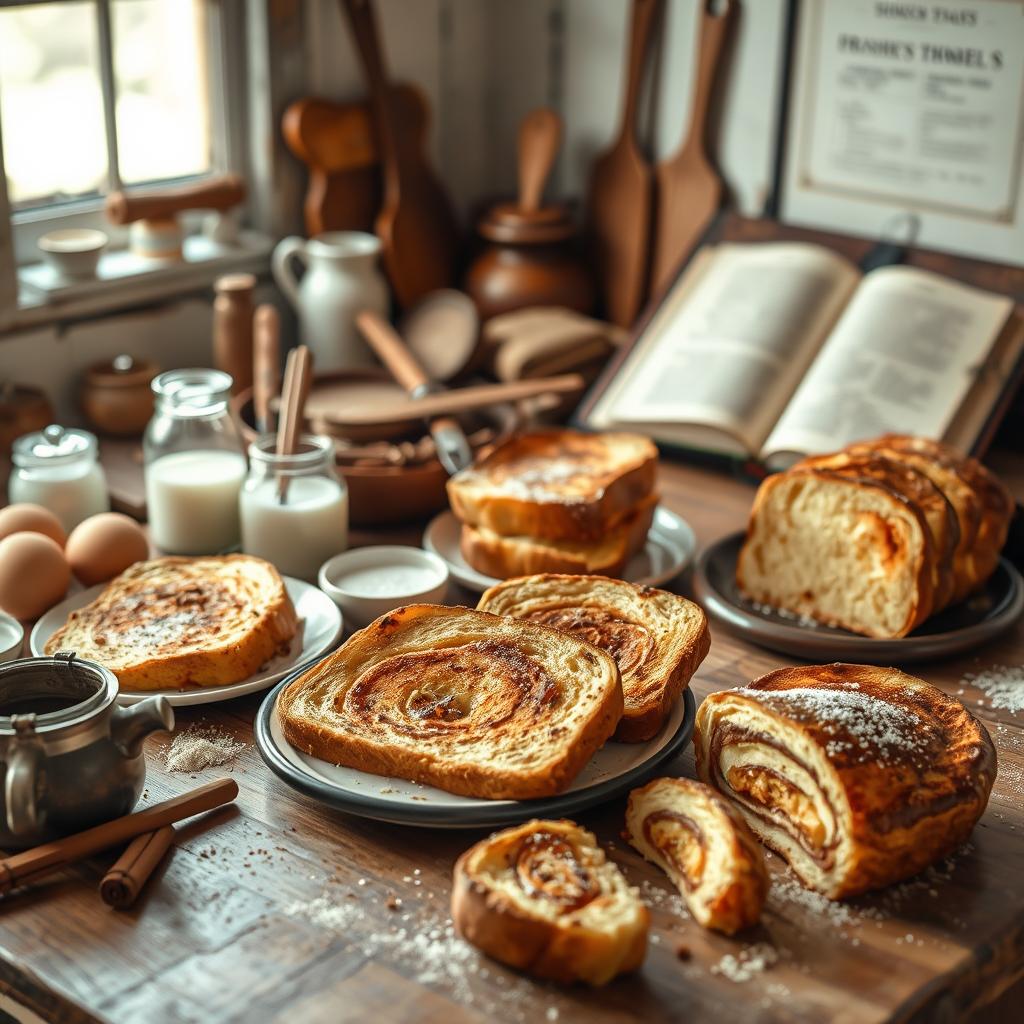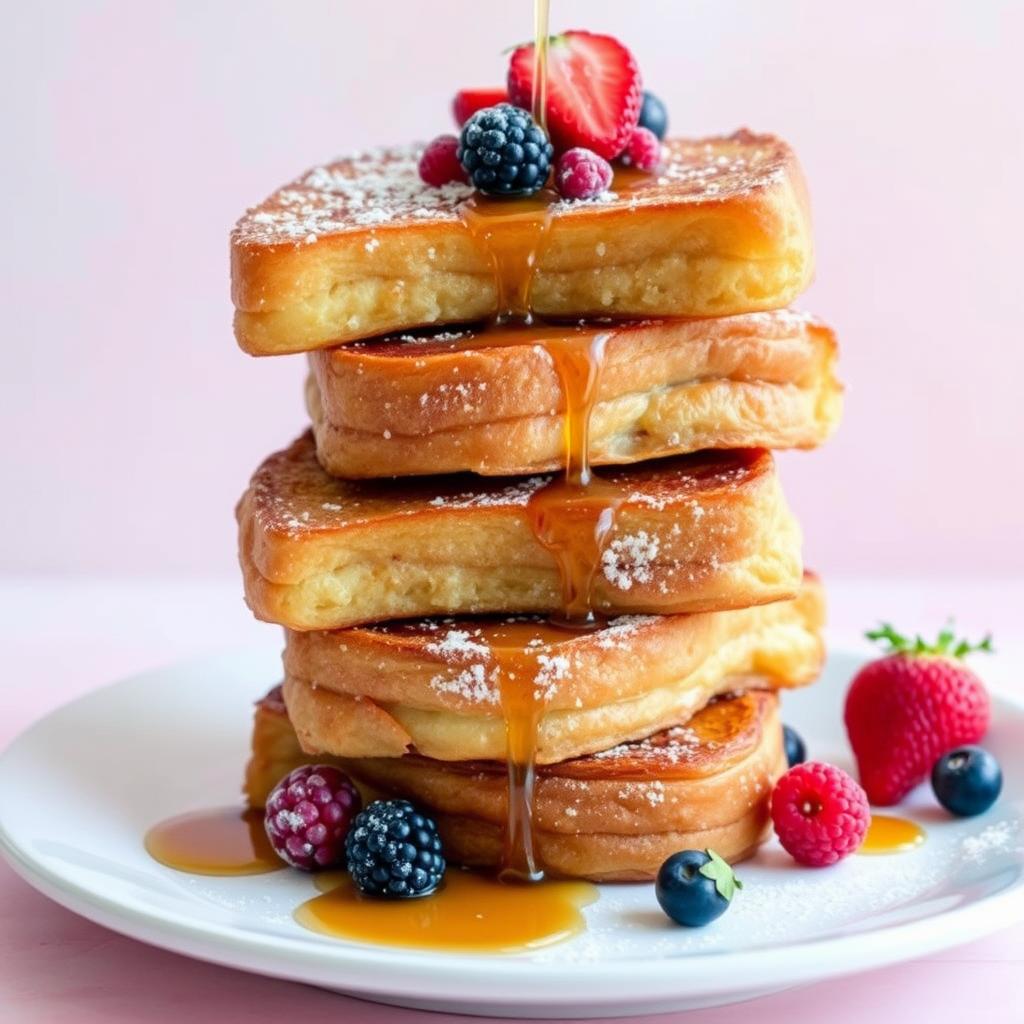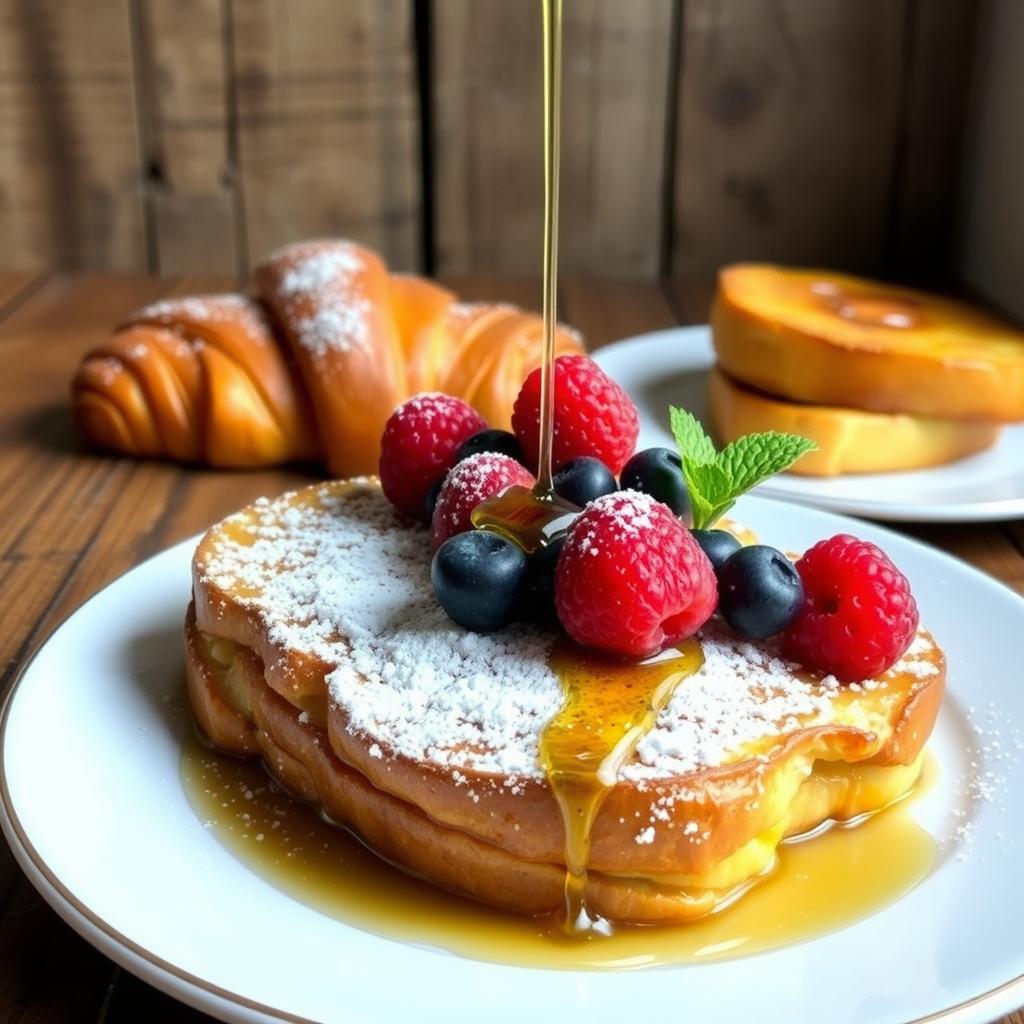Imagine turning a classic French pastry into the ultimate breakfast treat. Croissant French toast makes your morning meal special. It combines the buttery layers of a croissant with the rich, custardy essence of French toast.
This brunch delicacy adds a luxurious twist that will excite your taste buds. Unlike regular French toast, croissant French toast has a flaky, delicate texture. It makes every bite a gourmet experience. You’ll find a breakfast option that feels both indulgent and sophisticated.
Whether you’re planning a weekend brunch or just want a special breakfast, croissant French toast is perfect. It brings together French pastry techniques and classic breakfast comfort. It’s sure to make your morning routine special.
Key Takeaways
- Combines croissant’s flakiness with traditional French toast custard
- Perfect for weekend brunches and special occasions
- Elevates standard breakfast into a gourmet experience
- Offers a unique texture and rich flavor profile
- Versatile dish that can be customized with various toppings
The History and Origins of French Toast Evolution
French toast has a long and interesting history. It started as a simple way to use up old bread and has become a favorite breakfast dish. Its origins show how deeply connected food is to culture.

From Ancient Rome to Modern Brunch Tables
The history of french toast begins in ancient Rome. Cooks there found a way to make stale bread edible again. They soaked it in milk and eggs, a method that spread throughout Europe.
- Ancient Romans called this dish pan dulcis
- Early versions were a way to prevent food waste
- Served as a practical meal for using hard bread
The French Connection: Pain Perdu Heritage
In France, this dish was known as pain perdu, or “lost bread”. French bakers turned stale bread into a fancy breakfast dish. This shows how creativity in the kitchen can make simple things special.
“Waste not, want not” – A principle that birthed french toast
Evolution into a Global Breakfast Phenomenon
What started as a way to use up old bread is now loved worldwide. Different places have added their own twists to french toast. But the basic idea of bread soaked in egg and fried remains the same.
- Spread across European kitchens
- Adapted by American breakfast culture
- Transformed into gourmet brunch item
Today, french toast is more than just food. It shows how creativity in cooking can turn simple ingredients into something amazing.
What Makes Croissant French Toast Special

Imagine turning a French pastry into a special breakfast treat. Croissant French toast makes breakfast even better. It uses the flaky pastry’s unique qualities.
When you think of a French croissant, you might think of its buttery taste and layered texture. These traits make croissant French toast stand out. It’s far better than regular French toast.
- Luxurious layers of buttery flavor
- Crisp exterior with a tender interior
- Exceptional texture that melts in your mouth
The magic of croissant French toast is in its transformation. The custard soaks into the layers, making each bite a mix of flavors. The pastry absorbs the egg mixture in a way regular bread doesn’t, making it richer.
“A croissant is not just bread, it’s an experience of culinary artistry.” – Anonymous French Baker
Once you try croissant French toast, your breakfast will change. It combines crispy edges, a soft center, and a rich buttery taste.
Essential Ingredients for Perfect Croissant French Toast
Making great croissant French toast starts with top-notch ingredients. These turn a simple breakfast into a feast for the senses. Let’s explore the key elements that make this dish stand out.
Selecting the Right Croissants
Choosing the right croissants is crucial. Look for fresh, buttery ones with lots of flaky layers. Bakery-fresh croissants are best, especially day-old. They soak up the custard batter perfectly without falling apart.
- Seek out butter croissants with golden, crisp exterior
- Avoid pre-packaged or stale croissants
- Select medium-sized croissants for optimal texture
Creating the Perfect Custard Mixture
Your custard batter is key to a memorable French toast. Mix eggs, milk, vanilla extract, and cinnamon. This creates a rich, tasty base.
“The key to an incredible custard is balancing flavors and ensuring smooth consistency.” – Pastry Chef
Optional Add-ins and Flavor Enhancers
Make your croissant toast even better with creative add-ins. Try different toppings and mix-ins to find your favorite.
- Vanilla bean paste for depth
- Orange zest for brightness
- Almond extract for nutty undertones
- Maple syrup as a finishing touch
Pro tip: Always let your croissants soak in the custard mixture for at least 10 minutes to ensure maximum flavor absorption.
Step-by-Step Preparation Guide
Making perfect croissant French toast is a fun weekend treat. It turns a simple morning into a fancy meal. To get it right, you need to prepare well and use the right techniques.
First, get your ingredients ready and mix a rich custard. Knowing how long to toast a croissant is key. You want it golden outside and soft inside.
- Choose fresh, top-quality croissants from a local bakery
- Make a creamy custard with:
- Eggs
- Heavy cream
- Vanilla extract
- Pinch of cinnamon
- Soak croissants in custard for 2-3 minutes
Temperature and time are very important. Professional chefs say to use medium-low heat for even cooking.
| Cooking Stage | Temperature | Cooking Time |
|---|---|---|
| Preheating Skillet | Medium-Low (325°F) | 3-4 minutes |
| Toasting Croissant | Medium-Low | 2-3 minutes per side |
“The secret to perfect croissant French toast is patience and gentle heat.”
With practice and focus, you’ll get better at this breakfast skill. Soon, your weekend treat will be a true culinary delight!
Tips for Achieving the Perfect Texture
Making the perfect croissant French toast takes skill and love. It’s all about getting the crispy outside and soft, buttery inside just right.
The texture of French toast is key to a great meal. Mastering a few techniques can turn simple ingredients into a dish to remember.
Achieving the Golden-Brown Exterior
For a beautiful golden-brown crust, follow these tips:
- Use a cast-iron skillet for even heat distribution
- Butter the pan lightly before cooking
- Cook on medium-low heat to prevent burning
Maintaining the Flaky Pastry Interior
To keep the pastry flaky, handle it with care. Your croissants should be a bit stale but not dry. This helps them soak up the custard without losing their shape.
| Technique | Impact on Texture |
|---|---|
| Brief custard soak | Prevents soggy centers |
| Room temperature ingredients | Ensures even cooking |
| Gentle handling | Maintains pastry layers |
Temperature and Timing Considerations
Timing is everything when making croissant French toast. Cook for 2-3 minutes on each side. This way, you get a golden-brown outside and a soft, buttery inside.
“Perfection is about technique, not just ingredients” – Culinary Wisdom
Creative Toppings and Serving Suggestions
Make your croissant French toast a showstopper for your weekend. The right toppings can turn a simple dish into a feast for the eyes and taste buds.
Maple syrup is always a hit, but try new flavors too. Discover amazing combinations that will make your breakfast unforgettable.
- Fresh Berry Medley: Sprinkle fresh strawberries, blueberries, and raspberries for a burst of color and natural sweetness
- Nutty Crunch: Scatter toasted almonds, pecans, or walnuts for added texture
- Decadent Chocolate Drizzle: Warm chocolate sauce or Nutella can transform your dish
- Whipped Cream Elegance: Add a dollop of homemade whipped cream for luxurious richness
Make your dish look as good as it tastes. A beautiful presentation can make your weekend indulgence feel like a fancy meal.
| Topping Category | Recommended Options | Flavor Profile |
|---|---|---|
| Fruit-Based | Fresh berries, caramelized bananas | Sweet, tangy, refreshing |
| Cream-Based | Mascarpone, whipped cream | Rich, smooth, indulgent |
| Sauce Options | Maple syrup, chocolate, caramel | Sweet, decadent, varied |
“The art of a perfect breakfast is not just in cooking, but in how beautifully you present it.” – Culinary Experts
Your croissant French toast is a blank canvas for creativity. Try different toppings to find your favorite maple syrup breakfast. Make every weekend morning special with your own twist.
Pairing Your Croissant French Toast
To make your brunch better, choose pairings that match the croissant French toast’s rich taste. French cuisine has many great options to make your breakfast special.
Perfect Beverage Selections
Choose a drink that’s as good as your breakfast. Here are some French-inspired drinks:
- Café au Lait: A French coffee with steamed milk
- Freshly brewed French press coffee
- Champagne mimosa
- Herbal tea with lavender notes
Complementary Side Dishes
Make your croissant French toast even better with side dishes that add flavor and texture:
| Side Dish | Flavor Profile |
|---|---|
| Herb-roasted potatoes | Savory and crisp |
| Maple-glazed bacon | Sweet and smoky |
| Charcuterie selection | Rich and elegant |
Seasonal Fruit Combinations
French cooking loves fresh, seasonal foods. Try these fruit pairings with your croissant French toast:
- Summer: Fresh berries and peach compote
- Autumn: Poached pears with cinnamon
- Winter: Caramelized citrus segments
- Spring: Macerated strawberries
“The art of French dining is not just about food, but about creating a sensory experience.”
Make-Ahead and Storage Tips
Preparing croissant French toast ahead of time can save you a lot of stress. It’s perfect for busy mornings. You can still enjoy its amazing taste and texture.
Storing your croissant French toast right is key. It’s like preserving bread pudding. This way, it stays as tasty as when you first made it.
- Refrigeration Method:
- Store cooked croissant French toast in an airtight container
- Place parchment paper between layers to prevent sticking
- Refrigerate for up to 3 days
- Freezing Options:
- Wrap individual pieces in plastic wrap
- Place in freezer-safe bags
- Freeze for up to 2 weeks
Reheating is important when eating croissant toast. Here are the best ways to do it:
- Oven Reheating:
- Preheat to 350°F
- Place on a baking sheet
- Warm for 5-7 minutes
- Toaster Oven:
- Use medium-low setting
- Toast for 2-3 minutes
- Watch to prevent burning
“Preserving the crisp exterior and soft interior is the key to enjoying leftover croissant French toast.” – Culinary Expert
Pro tip: Turn leftover croissant French toast into a dessert. Cube the toast and mix with a rich custard. This way, you won’t waste any of it.
Conclusion
Croissant French toast turns a regular breakfast into a special weekend treat. By learning the right techniques and trying new variations, you can make it a gourmet delight. You can also add your own twist with unique toppings and sauces.
Start by picking the best croissants and making the perfect custard. Whether you like the classic or something new, there’s a version for everyone. The fun is in trying different ingredients and methods to find what you like best.
See croissant French toast as a way to celebrate flavors and creativity in the kitchen. Begin with the basics from this guide, but feel free to add your own touch. Your weekend mornings will be filled with joy and this delicious breakfast.
Cooking is about passion, fun, and sharing great moments with loved ones. Your croissant French toast can become a special tradition that adds warmth and excitement to your mornings.
FAQ
What is the origin of French toast?
French toast has ancient roots, dating back to Rome. It was a way to use up stale bread. In France, it’s called “pain perdu,” or lost bread, showing its resourceful use of bread that would otherwise be thrown away.
How is croissant French toast different from traditional French toast?
Croissant French toast uses flaky, buttery croissants instead of regular bread. This makes the dish more luxurious, with a richer texture and flavor. It combines the custard-soaked interior with the croissant’s layers.
What are the key ingredients for making croissant French toast?
You’ll need fresh croissants, eggs, milk or cream, vanilla extract, cinnamon, and a pinch of salt. You can also add butter for cooking and toppings like maple syrup, fresh berries, or powdered sugar.
How long should I soak the croissants in the custard?
Soak the croissants for 30 seconds to 1 minute per side. Be gentle to avoid making them soggy, as they are more delicate than regular bread.
Can I prepare croissant French toast in advance?
Yes, prepare the custard and slice the croissants the night before. Keep them in the fridge and cook just before serving. This way, you’ll get a crispy exterior and a soft interior.
What are the best toppings for croissant French toast?
Try maple syrup, fresh berries, whipped cream, and powdered sugar for a classic taste. For something more indulgent, add chocolate sauce, caramel, or a dollop of mascarpone cheese.
What beverages pair well with croissant French toast?
Pair it with fresh coffee, cappuccino, or a mimosa for a classic choice. For a non-alcoholic option, orange juice or a fruit smoothie works well to complement the buttery flavors.
How do I achieve the perfect golden-brown exterior?
Cook the croissants in butter over medium-low heat for 2-3 minutes per side. This method ensures a crispy exterior while keeping the inside soft and custardy.
Can I make a vegetarian or dairy-free version?
Yes! Use plant-based milk and replace eggs with cornstarch and milk or a commercial egg substitute. Choose dairy-free croissants for a vegan-friendly dish.
What’s the best way to store leftover croissant French toast?
Store it in an airtight container in the fridge for up to 2 days. Reheat in a toaster oven or air fryer to keep it crispy. Avoid the microwave to prevent sogginess.


1 thought on “Satisfy Your Cravings with Croissant French Toast”